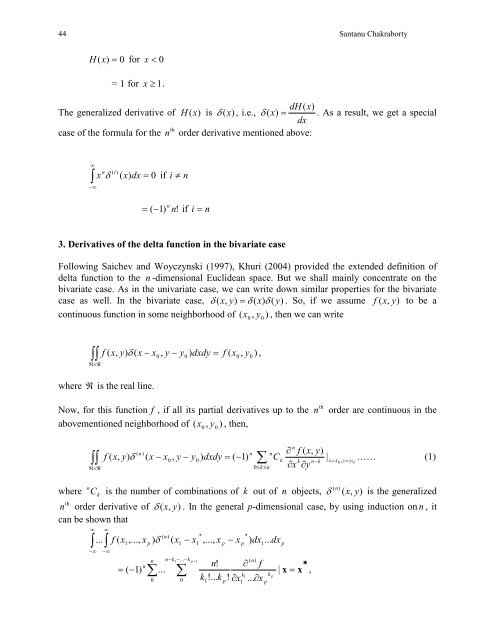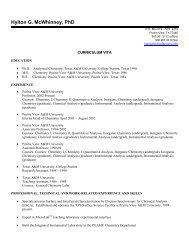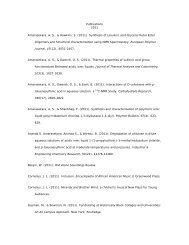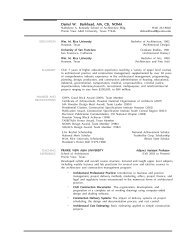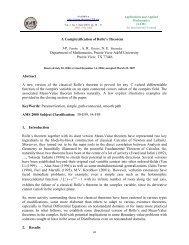Some applications of Dirac's delta function in Statistics for more than ...
Some applications of Dirac's delta function in Statistics for more than ...
Some applications of Dirac's delta function in Statistics for more than ...
You also want an ePaper? Increase the reach of your titles
YUMPU automatically turns print PDFs into web optimized ePapers that Google loves.
44 Santanu Chakraborty<br />
H ( x)<br />
= 0 <strong>for</strong> x < 0<br />
= 1 <strong>for</strong> x ≥ 1.<br />
dH ( x)<br />
The generalized derivative <strong>of</strong> H (x)<br />
is δ (x)<br />
, i.e., δ ( x)<br />
= . As a result, we get a special<br />
dx<br />
th<br />
case <strong>of</strong> the <strong>for</strong>mula <strong>for</strong> the n order derivative mentioned above:<br />
∞<br />
∫<br />
−∞<br />
n ( i)<br />
x δ ( x)<br />
dx = 0 if i ≠ n<br />
( 1)<br />
n!<br />
n<br />
= − if i = n<br />
3. Derivatives <strong>of</strong> the <strong>delta</strong> <strong>function</strong> <strong>in</strong> the bivariate case<br />
Follow<strong>in</strong>g Saichev and Woyczynski (1997), Khuri (2004) provided the extended def<strong>in</strong>ition <strong>of</strong><br />
<strong>delta</strong> <strong>function</strong> to the n -dimensional Euclidean space. But we shall ma<strong>in</strong>ly concentrate on the<br />
bivariate case. As <strong>in</strong> the univariate case, we can write down similar properties <strong>for</strong> the bivariate<br />
case as well. In the bivariate case, δ ( x, y)<br />
= δ ( x)<br />
δ ( y)<br />
. So, if we assume f ( x,<br />
y)<br />
to be a<br />
cont<strong>in</strong>uous <strong>function</strong> <strong>in</strong> some neighborhood <strong>of</strong> x , ) , then we can write<br />
∫∫<br />
ℜ×<br />
ℜ<br />
( 0 0 y<br />
f x,<br />
y)<br />
δ ( x − x , y − y ) dxdy = f ( x , y ) ,<br />
( 0 0<br />
0 0<br />
where ℜ is the real l<strong>in</strong>e.<br />
Now, <strong>for</strong> this <strong>function</strong> f , if all its partial derivatives up to the th<br />
n order are cont<strong>in</strong>uous <strong>in</strong> the<br />
abovementioned neighborhood <strong>of</strong> x , ) , then,<br />
( 0 0 y<br />
∂ f ( x,<br />
y)<br />
δ …… (1)<br />
n<br />
( n)<br />
n n<br />
∫∫ f ( x,<br />
y)<br />
( x − x0<br />
, y − y0<br />
) dxdy = ( −1)<br />
∑ Ck<br />
|<br />
k n−k<br />
x=<br />
x0<br />
, y=<br />
y0<br />
ℜ×<br />
ℜ<br />
0≤k<br />
≤n<br />
∂x<br />
∂y<br />
n ( n)<br />
where C k is the number <strong>of</strong> comb<strong>in</strong>ations <strong>of</strong> k out <strong>of</strong> n objects, δ ( x,<br />
y)<br />
is the generalized<br />
th<br />
n order derivative <strong>of</strong> δ ( x,<br />
y)<br />
. In the general p-dimensional case, by us<strong>in</strong>g <strong>in</strong>duction on n , it<br />
can be shown that<br />
∞ ∞<br />
∫... ∫<br />
( n)<br />
f ( x1,...,<br />
x p ) δ ( x1<br />
*<br />
*<br />
x1<br />
,..., x p − x p ) dx1...<br />
−∞<br />
−∞<br />
∂<br />
= − ∑ ∑<br />
∂ ∂<br />
−<br />
n n−k1<br />
−...<br />
−k<br />
p 1<br />
( n)<br />
n<br />
n!<br />
f<br />
( 1)<br />
...<br />
k1<br />
k p<br />
0 0 k1!...<br />
k p!<br />
x1<br />
... x p<br />
− dx p<br />
| x = x<br />
*<br />
,


